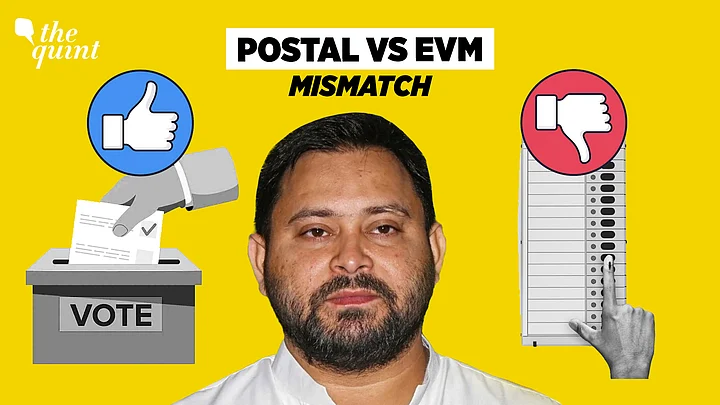The National Democratic Alliance has swept the Bihar Assembly elections, winning 202 out of 243 seats in the state. But curiously, the trends in postal votes were the complete opposite. In 142 constituencies, the Mahagathbandhan was leading postal votes as opposed to the NDA's 98.
This comparison is important because Leader of the Opposition Rahul Gandhi gave the example of postal votes in his recent press conference accusing malpractices in the 2024 Haryana Assembly election results. In Haryana, the Congress was leading in 73 constituencies in postal votes against the BJP's 17 even though the overall result was 37 and 48 seats for the two parties respectively. This was among the many data points Rahul Gandhi cited to question the Haryana results.
So what does the data say in Bihar?
Does this necessarily mean that there has been tampering with the electoral process?
We'll examine both these questions in this piece.
Mahagathbandhan Lead in Postal Votes
There were as many as 110 seats in Bihar where the NDA was leading in EVM votes but the Mahagathbandhan was leading in postal votes.
For example, let's take the Laukaha seat, which the JD(U) won by over 25,000 votes. Here the RJD secured 664 postal votes against the JD(U)'s 346. There are over 100 seats like this.
On the other hand, in only 7 seats the situation was the other way around: the Mahagathbandhan getting more EVM votes but less postal votes than the NDA.
The Mahagathbandhan was leading in postal votes in four out of five seats won by the All India Majlis-e-Ittehadul Muslimeen (AIMIM). In the fifth AIMIM seat, Jokihat, Prashant Kishor's Jan Suraaj Party was leading in terms of postal votes, despite standing third in terms of EVM votes in the seat.
Jan Suraaj Party has generally performed better in postal votes than it has in EVM votes. It is the number three party in a majority of seats in terms of postal votes.
So does this mean there's a discrepancy? Before we get to his, we first need to understand who gets to vote through postal votes.
Who Gets to Vote by Postal Ballots?
The biggest chunk of postal ballot voters are armed forces and paramilitary personnel who have been posted in different parts of the country and are, therefore, unable to come to the polling booth to vote. Then there are government officers, police personnel and others who have been posted on poll duty. Those in preventive detention and special voters such as the President of India, Vice-President and Governors are also eligible for postal votes but these are very small in number.
The EC has extended postal voting rights to:
Electors above the age of 85 years and electors with benchmark disabilities. But they would need to submit Form D and submit to the Returning Officer through their BLO within 5 days of issuance of notification of election. Polling teams will collect their votes at their homes.
Electors on essential services on the date of poll such as Fire Services, Health, Electricity, Traffic, Ambulance Services, Aviation, long-distance Government Road Transport Corporations etc. are covered under this facility.
Media persons authorized by the Election Commission for poll day coverage have also been included in the category of absentee voters on essential services entitled to postal ballot facility.
During the COVID-19 pandemic, Coronavirus patients above a certain age were also entitled to postal voting.
A vast majority of postal voters are government employees, with security personnel being the biggest chunk. Therefore, postal votes are often seen as reflective of the sentiment of these sections.
According to reports, the BJP gained because of postal votes during the 2019 Lok Sabha elections due to the sentiment in the armed forces after the Pulwama Attack and Balakot strike. Postal votes helped BJP clinch close seats like Rohtak in Haryana and Chamarajanagar in Karnataka.
However, the BJP's support among this section has suffered some losses. For instance, in the 2022 Uttar Pradesh elections, the BJP and its allies were almost 20 percentage points behind the SP-led alliance in terms of postal votes even though the won the state overall.
When Can Postal Votes Diverge from EVM Votes?
Armed forces personnel and government employees don't exist in a vacuum and therefore it is curious if they are voting in a completely different direction from the rest of the electorate.
However, there are factors which could lead to a divergence.
First, postal voters are not subject to polling day mobilisation by parties to the same extent as polling booth voters. Therefore, parties who rely a lot on 'ground game' may not have the same advantage among postal voters which they have in terms of EVM votes.
Second, men account for a disproportionately large chunk of postal voters, mainly due to a majority of security personnel and government officers being men. So if there is a gender based divergence in voting, as many surveys did indicate in the context of Bihar, it may get amplified in postal votes.
Third, issues like One Rank One Pension and Agniveer become much more important for postal voters.
These factors could potentially explain part of the divergence between postal and EVM votes. Do these explanations completely rule out any possibility of the kind of malpractice Rahul Gandhi alleged in the case of Haryana? The divergence between postal and EVM votes is very substantial so we cannot conclusively prove or disprove any malpractise.
One aspect is clear. It is significant that a majority of armed forces personnel in Bihar seem to have voted against the NDA despite the fact that the country went through a war with Pakistan earlier this year.
